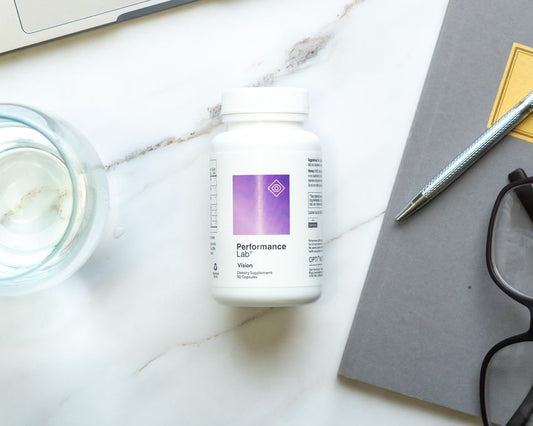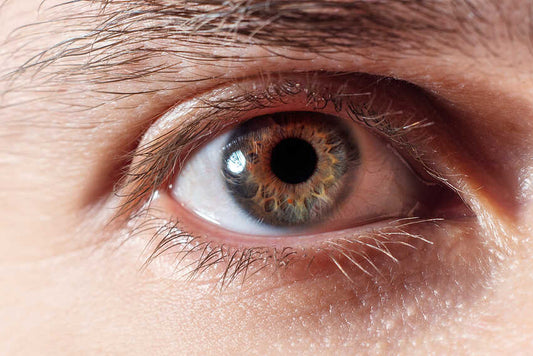If you live in a climate where you get winter, you're probably familiar with your skin drying out when the temperature drops. But while the cold tends to be a bit rougher on your skin, dry skin doesn't have to happen.
Omega-3s work wonders in your body to maintain skin health and hydration, even during colder months. But can they do the same for dry eyes?
We're going to help you understand the importance of omega-3s not just for your skin, but your entire body, including your eyes, and what the best source is.
What Are Omega-3s?
Omega-3s, also referred to as essential fatty acids, are called 'essential' because they cannot be produced in the body. As such, they must come from exogenous sources like supplementation and diet.
They are polyunsaturated fatty acids that can be broken down further into two categories: omega-3 (ω-3) and omega-6 (ω-6). While omega-9s (ω-9) are technically part of EFAs, they're not essential because they can be produced endogenously from unsaturated fats.
Here, however, we're just going to focus on the role of omega-3s in eye health.
The three you'll commonly see are:
- Eicosapentaenoic acid (EPA)
- Docosahexaenoic acid (DHA)
- Alpha-linolenic acid (ALA)
While all three EFAs are necessary for the body, getting adequate amounts of EPA and DHA on a vegan diet without supplementation can be challenging.
Conversion of linoleic acid (LA), and omega-6, to arachidonic acid (AA), a pro-inflammatory omega-6, competes with the conversion of ALA to EPA and DHA 1.
As such, the conversion rate of ALA to EPA or DHA is relatively minimal. In other words, consumption of excess LA generates excess AA, a pro-inflammatory omega-6, in relation to EPA and DHA, thereby leading to a more pro-inflammatory state, which can result in ocular issues.
What Causes Dry Eyes?
When it comes to what causes dry eyes, there can be several underlying conditions associated with it.
Dry eye syndrome (DES) is thought to develop from an abnormality or dysfunction of the tear film, causing increased evaporation and resulting damage to the interpalpebral ocular surface, which is typically associated with symptoms of ocular discomfort 1, 2.
However, it can also stem from lid closure abnormalities or certain environmental or physical conditions (wind, air conditioning, contact lenses, etc.).
In general, dry eye is characterized by ocular surface damage, reduced tear film stability, and tear hyperosmolarity, but more recent research suggests there may also be an inflammatory component 3.
More recent studies have looked into the link between nutrition and dietary modification in treating and preventing dry eye.
Related Post: Vitamin C and Dry Eyes
Nutrition and Dry Eye
There's a fair amount of research available to support the role of EFAs in eye health and treating dry eye.
Essential fatty acids (EFAs) may help to enhance the lipid layer of the tear film, thus preventing evaporation, but perhaps more critical is the anti-inflammatory property that EFAs possess.
It's well-known that omega-3s and omega-6s should be consumed together, as they are both essential and required for a multitude of functions.
However, a lack of omega-3 intake can lead to improper ratios and overexposure of omega-6 to omega-3 fatty acids 1.
As supplementing with omega-3s elicits an anti-inflammatory effect and inhibits inflammatory prostaglandins, it's key to ensure adequate intake.
Omega-3s have also been shown to exhibit an anti-inflammatory function in the lacrimal gland which may help prevent death or damage to the secretory epithelial cells and clear up meibomitis, allowing for a thinner, more elastic lipid layer that protects the tear film and cornea.
The Link Between Omegas And Your Eyes
Omega-6s
There's no denying the role of omega-6 fatty acids in dry eye disease. Both LA (linoleic acid) and GLA (gamma-linoleic acid) play an important role in meibomian gland dysfunction (MGD); Meibomian gland secretion is key for stabilizing the tear film and MGD 1.
Omega-6s appear to elicit an anti-inflammatory effect in the eye, improving the lacrimal function and health of the ocular surface. Omega-6 EFAs may also help to increase tear secretion 4, 5.
Omega-3s
Omega-3 fatty acids are one of the best nutrients for keeping eyes lubricated and vision sharp.
Why? Because like omega-6s, omega-3s help to nourish and support specific glands in your eyes called Meibomian glands, which produce the oily component of your tears 1.
This oily substance helps to keep eyes lubricated, moist, and prevents tears from evaporating.
But there is more when it comes to omega-3s and your eyes.
Specifically, DHA is found in very high concentrations in the retina's cell membranes, and studies have shown that when omega-3 intake is low, the retina conserves and recycles DHA 6.
This fatty acid is essential to the development of the retina, and deficiencies can cause permanent retinal function abnormalities.
There is also a large body of research supporting the role of DHA in the regeneration of the visual pigment rhodopsin, which is involved in the visual transduction system that converts light hitting the retina to visual images in the brain, as well as low-light vision 7.
Without dismissing the function of omega-6s in eye health, several studies have confirmed the link between omega-3s and dry eyes.
Evidence shows that a high intake ratio of omega-3s to omega-6s decreases the risk of dry eye syndrome in women 8. Ideally, this ratio should be somewhere around 1:2, but in a typical Western diet, that ratio is anywhere from 1:10 to 1:30.
One study specifically showed that women with an omega-3 to 6 ratio of 1:15 had a two-and-a-half times greater risk of dry eye syndrome 8. This is largely the result of imbalanced prostaglandin ratios, with excess pro-inflammatory PGE2 and lack of anti-inflammatory PGE1 and PGE3 9.
The Best Sources
When you think about omega-3s, fish is probably one of the first things that comes to mind. But not so fast—let's back up for a second.
Omega-3s come from two sources: aquatic life and plants. Plant sources are a super potent source of the omega-3 ALA and work wonders for reducing inflammation on the ocular surface 10, which may improve dry eyes.
These are your best sources of ALA 11:
- Flaxseed oil (1 tbsp., 7.3g)
- Chia seeds (1 oz., 5.1g)
- Walnuts (1 oz., 2.6g)
- Flaxseeds (1 tbsp., 1.6g)
- Walnut oil (1 tbsp., 1.4g)
On the other hand, we have EPA and DHA, which are found in minimal quantities in plant foods, and even if they are, the conversion rate does not sustain adequate serum levels.
So, while oily fish like salmon, anchovies, herring, sardines, and mackerel are technically all great sources of omega-3 fatty acids and loaded with beneficial nutrients, it's essential to keep in mind that there are also some negatives when it comes to fish-derived omega-3s.
Here's what you need to know 12:
- They're unsustainable—The commercial fishing industry is far from good for the planet. Overfishing and bycatch are two huge problems associated with the industry, and the number of over-fished stocks has been steadily increasing since the 1950s.
- They're often contaminated—Chemical contaminants are quite common in fish oils, some of which can be highly toxic to humans.
- They may be rancid—EFAs are highly delicate oils, and often, processing and improper storage can mean they're rancid before they even reach your mouth.
Here's a kicker for you: did you know that everything you thought about the source of omega-3s may not be accurate? Fish don't actually synthesize EPA and DHA. Rather, it accumulates in their tissues from what they eat—algae.
Algae is the primary source of EPA and DHA and a much cleaner, safer, and vegan-friendly source.
So, in the interest of both your health and the environment, say goodbye to fish oils and invest in the direct source of omega-3s.
Performance Lab Omega-3 offers supplies safe, clean, and sustainable EPA+DHA Omega-3s directly from their original source in all aquatic ecosystems: algae.

Complete with life's™OMEGA algal oil, Performance Lab Omega-3 supplies all the high-potency EPA+DHA benefits, without the fish oil concerns.
It's ultraclean, containing no heavy metals, PCBs, or toxic contaminants; is environmentally friendly and sustainable, and traceable from start to finish.
And if that's not enough, combining Omega-3 with Performance Lab Vision is the key to crystal-clear visual performance, high-speed focus, and overall eye health, as well as reducing the risk of or improving symptoms of dry eye.

It's one of the best vision supplements on the market loaded with six potent antioxidants to reduce inflammation and protect your eyes.
References
- M Roncone, H Bartlett, F Eperjesi. Essential fatty acids for dry eye: A review. Cont Lens Anterior Eye. 2010;33(2):49-100.
- MA Lemp. Report of the National Eye Institute/Industry workshop on Clinical Trials in Dry Eyes. CLAO J. 1995;21(4):221-232.
- AJ Bron. Diagnosis of dry eye. Surv Ophthalmol. 2001;45 Suppl 2:S221-S226.
- BE Caffery. Influence of diet on tear function. Optom Vis Sci. 1991;68(1):58-72.
- KH Kokke, JA Morris, JG Lawrenson. Oral omega-6 essential fatty acid treatment in contact lens associated dry eye. Cont Lens Anterior Eye. 2008;31(3):141-170.
- BG Jeffrey, HS Weisinger, M Neuringer, DC Mitchell. The role of docosahexaenoic acid in retinal function. Lipids. 2001;36(9):859-871.
- JP SanGiovanni, EY Chew. The role of omega-3 long-chain polyunsaturated fatty acids in health and disease of the retina. Prog Retin Eye Res. 2005;24(1):87-138.
- B Miljanović, KA Trivedi, MR Dana, JP Gilbard, JE Buring, DA Schaumberg. Relation between dietary n-3 and n-6 fatty acids and clinically diagnosed dry eye syndrome in women. Am J Clin Nutr. 2005;82(4):887-893.
- A Pinna, P Piccinini, F Carta. Effect of oral linoleic and gamma-linolenic acid on meibomian gland dysfunction. Cornea. 2007;26(3):260-264.
- N Erdinest, O Shmueli, Y Grossman, H Ovadia, A Solomon. Anti-inflammatory effects of alpha linolenic acid on human corneal epithelial cells. Invest Ophthalmol Vis Sci. 2012;53(8):4396-4406. Published 2012 Jul 3.
- "Essential Fatty Acids." Linus Pauling Institute, 1 Jan. 2021, lpi.oregonstate.edu/mic/other-nutrients/essential-fatty-acids.
- TC Adarme-Vega, DK Lim, M Timmins, F Vernen, Y Li, PM Schenk. Microalgal biofactories: a promising approach towards sustainable omega-3 fatty acid production. Microb Cell Fact. 2012; 11: 96.
















